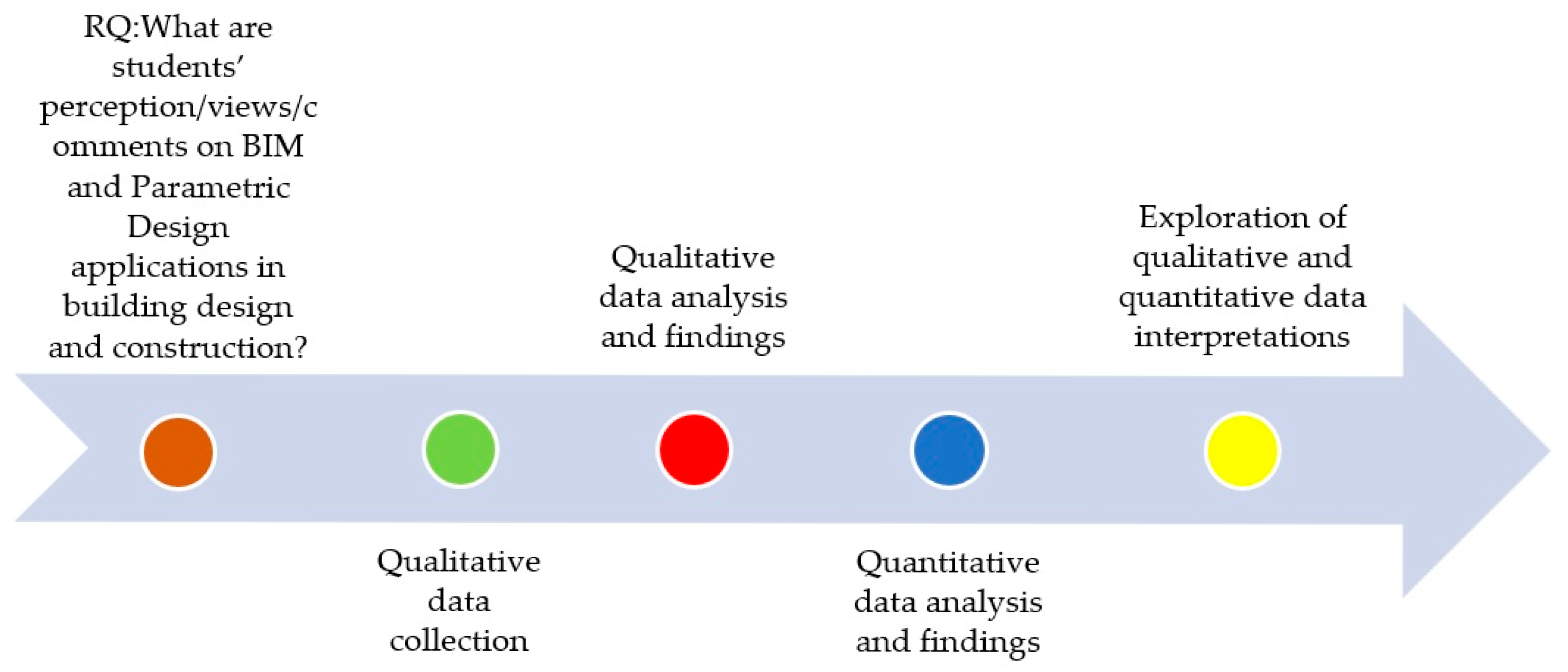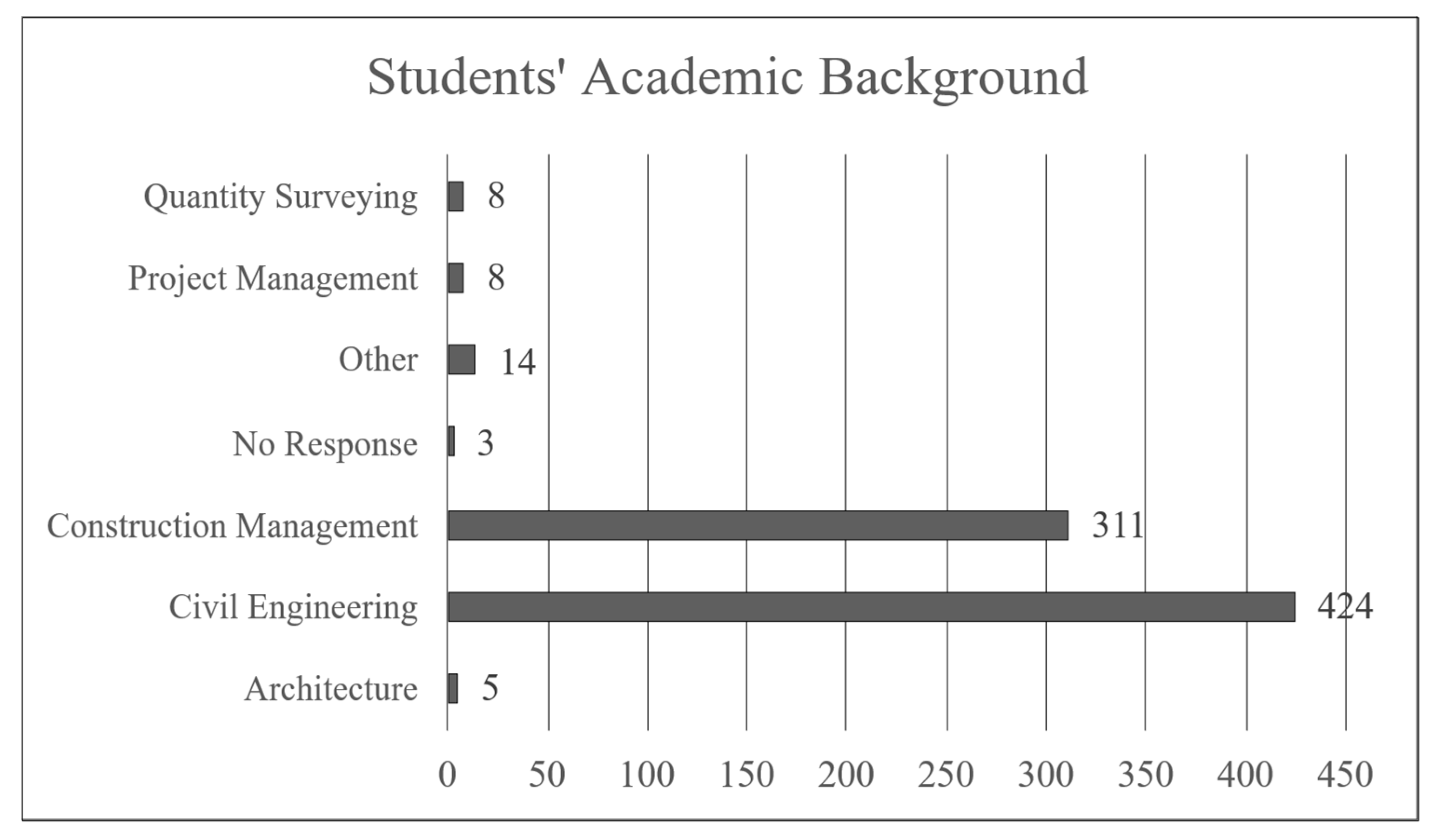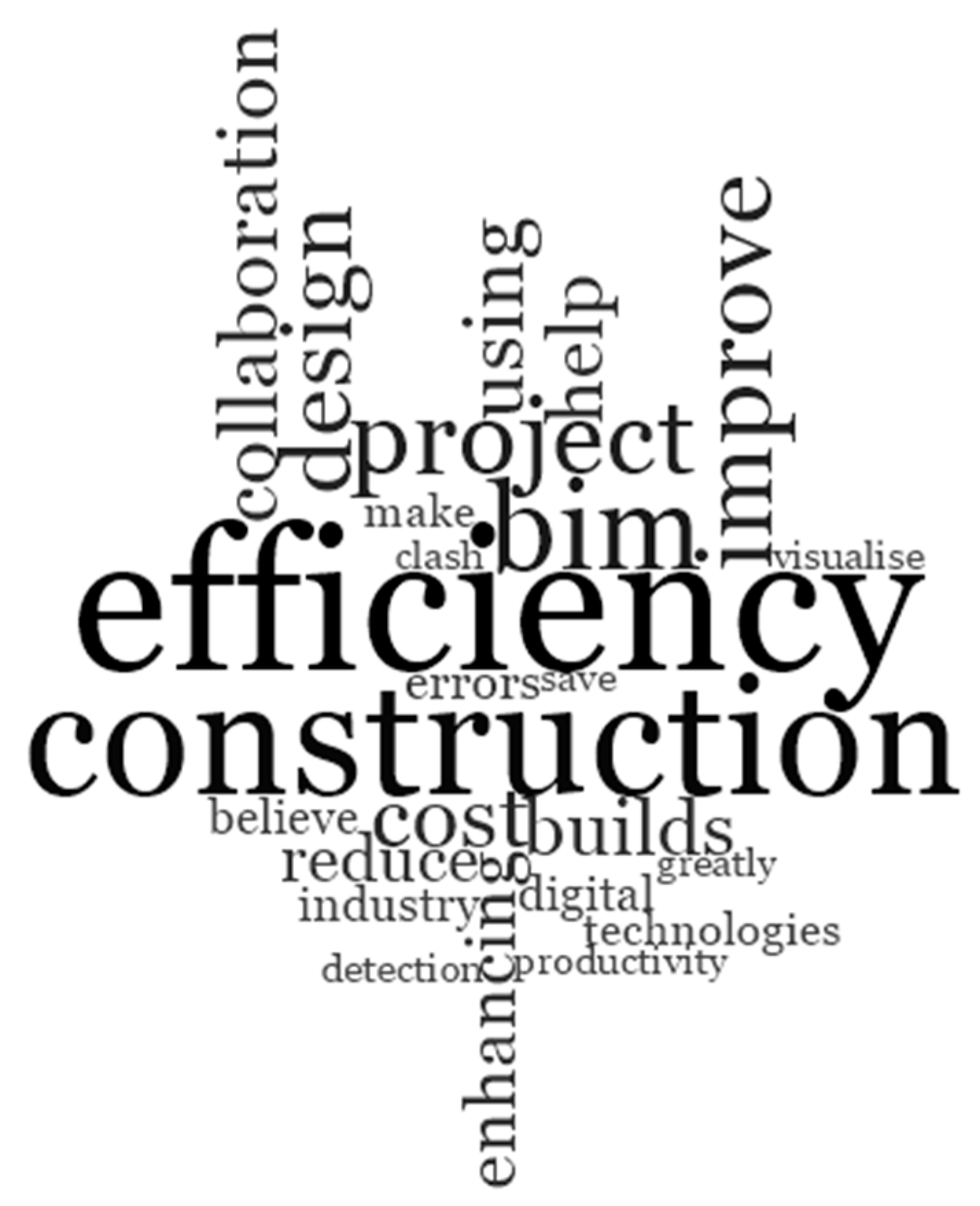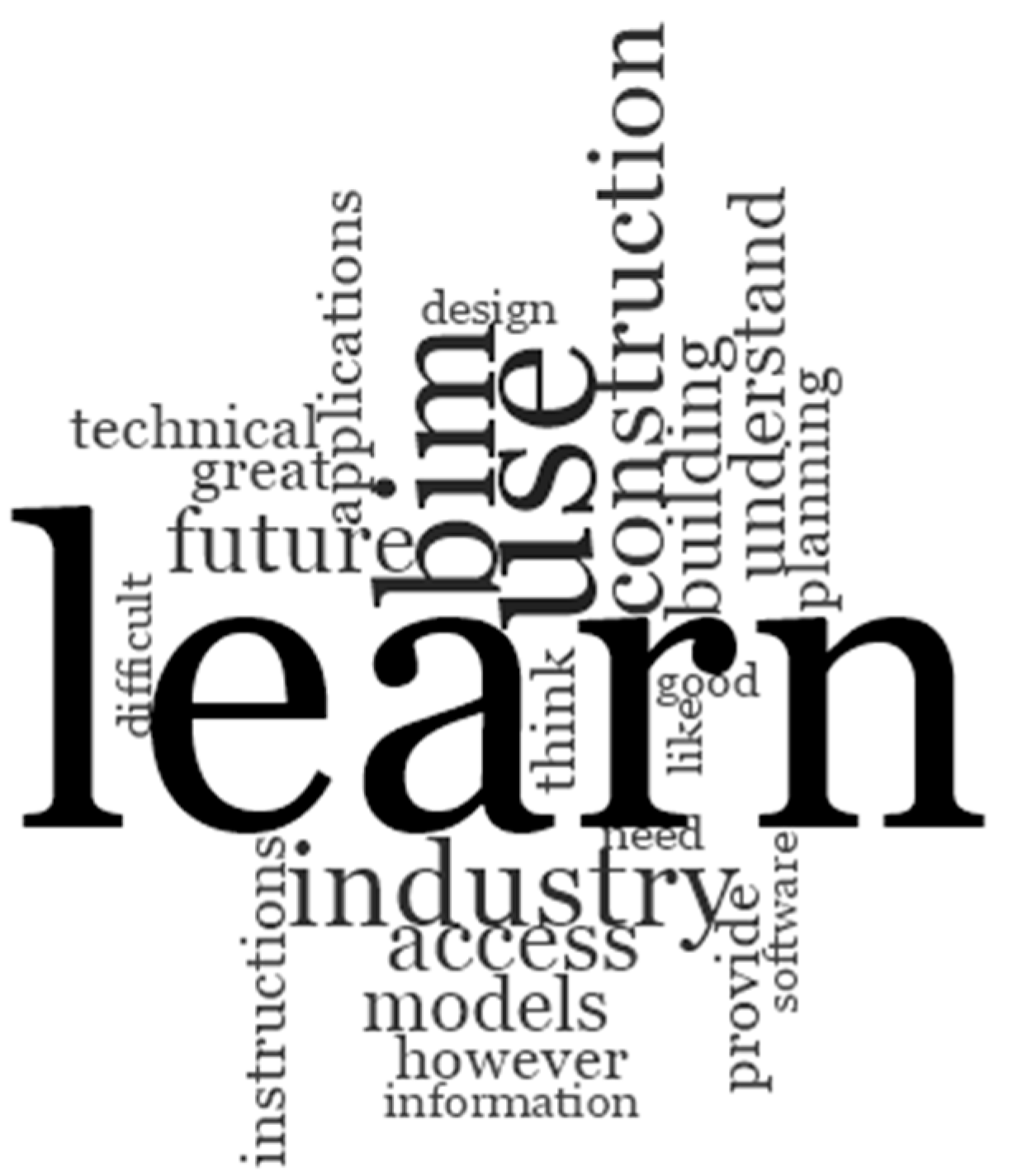Building Information Modelling (BIM) Acceptance and Learning Experiences in Undergraduate Construction Education: A Technology Acceptance Model (TAM) Perspective—An Australian Case Study
Abstract
1. Introduction
2. Literature Review
2.1. BIM in the Education Sector
2.2. The Technology Acceptance Model (TAM)
3. Research Methodology
3.1. Research Design
- Frequency analysis of acceptance themes,
- Relational analysis of construct interactions,
- Contextual analysis of representative narratives.
3.2. Survey Instrument
- Demographic Information: Students’ disciplinary focus (Construction Management, Civil Engineering, Quantity Surveying, Project Management, Architecture, or Other) and year level.
- Course Information: Whether the student was responding based on experience in a core or elective subject.
- Technology Experience: Previous exposure to and experience with BIM-AI technologies.
- Open-ended Response: The primary qualitative data collection point with the question: “What are your views/comments on BIM, Parametric Design, Digital Twins applications in building design and construction?”
3.3. Sample and Distribution
3.4. Data Analysis
3.4.1. Qualitative Content Analysis
- Familiarisation with Data: Initial reading of all responses to gain comprehensive understanding.
- Development of Coding Framework: Establishment of a preliminary coding structure based on TAM constructs.
- Initial Coding: Application of the preliminary framework to a subset of responses.
- Code Refinement: Revision and expansion of coding categories based on initial coding results.
- Comprehensive Coding: Systematic coding of all 607 substantive responses.
- Theme Development and Review: Identification and refinement of patterns and relationships between codes.
3.4.2. Keyword Development for Thematic Analysis
- Initial Keyword Identification: Based on the established TAM literature (Venkatesh & Bala, 2008) [42], an initial set of keywords was compiled for each construct.
- Contextual Adaptation: These keywords were adapted to the specific context of BIM-AI in construction education by the first two authors. In instances where the authors initially applied different codes, consensus was reached through discussion and clarification of the underlying rationale for each coding decision.
- Keyword Expansion: The initial keyword set was expanded through synonym generation and contextual analysis of a sample of survey responses, identifying domain-specific terminologies and expressions.
3.4.3. Analytic Strategy
- Frequency Analysis: Quantification of TAM constructs and sub-themes across the dataset, calculating both raw counts and proportional representation.
- Co-occurrence Analysis: Examination of relationships between constructs and sub-themes through matrix coding queries, identifying patterns of conceptual association.
- Contextual Analysis: In-depth examination of representative quotes for each identified theme to understand the nuanced meanings and contextual factors influencing student perceptions.
4. Analysis and Findings
4.1. Perceived Usefulness (PU)
4.1.1. Productivity Benefits
“I believe that BIM and Artificial Intelligence applications will be highly beneficial in construction as it will allow projects to operate more efficiently”.
“Personally, I believe that BIM, Digital Twins, and AI make construction more efficient”.
“Technologies such as BIM can offer tremendous potential to enhance efficiency, reduce costs, and improve the overall quality of construction projects”.
“BIM could help speed up work, ensuring compliance, aid in costing and maintenance”.
“BIM applications improve efficiency, save time, increase accuracy, and allow more time to be spent on improving other aspects of building and construction”.
4.1.2. Collaboration Enhancement
“BIM revolutionised the industry by allowing stakeholders to create, manage, and visualise detailed 3D models of buildings and infrastructure. This technology facilitates better collaboration among architects, engineers, contractors, and other stakeholders by providing a single source of truth”. (Civil Engineering discipline)
“BIM makes sharing information of design models, a simpler process”. (Construction Management discipline)
“My view on the adoption of BIM technology is a step forward for the construction industry as it enables collaboration between the stakeholders”. (Construction Management discipline)
4.1.3. Accuracy and Error Reduction
“I believe BIM is the way of the future as it eliminates the human element which is often the cause of error, leading to project budget and program overruns”.
“It could help speed up work, ensuring compliance, aid in costing and maintenance. It could also detect design errors and help create effective and usable spaces”.
4.2. Perceived Ease of Use (PEOU)
4.2.1. Learning Curve and Technical Complexity
“They are very technical and difficult to learn, especially multiple software’s in a semester. However very rewarding to maintain the final product”.
“Great however hard learning curve”.
“They seem to have a difficult learning curve to master however its very interesting”.
“If we learn, understand and apply these technologies we can foster an environment that develops a plethora of nuance solutions to the present and future problems we encounter”.
4.2.2. Information Accessibility
“I believe BIM to be an extremely valuable and informative tool in construction. It allows for easy understanding of a new development and provides information in an accessible format”.
4.3. Attitude Toward Using (ATU)
4.3.1. Very Positive Attitudes
4.3.2. Very Negative Attitudes (Concerns and Ambivalence)
4.4. Behavioural Intention to Use (BI)
“Although I don’t see BIM as something I am keen to learn, I do believe it is important for me to understand as I employ other people to use it in the future”.
“These technologies will surely be instrumental to the success of construction in the future. They are happening now, but the implementation will take some time”.
“I believe that as Automative and 3D modelling software become more available that it will provide great assistance to project team of all sizes and become more widely spread across all disciplines”.
“I think they are essential for the future of building and construction”.
“Exactly what I would like to aim my learning post-graduation as this is the direction that the construction industry is heading to in the near future”.
4.5. External Variables (EVs)
4.5.1. The Availability of Resources and Education
“It will be fascinating to grow forward to this type of future and learning in advance in university will guide us”. (Civil Engineering discipline)
“Very cool software, hope we get to use it in this course a lot”. (Construction Management discipline)
“Therefore, University’s should be teaching students how to use it effectively so that we are not left behind by future generations”. (Civil Engineering discipline)
“However, the introduction of these technologies also requires adapting to new workflows, training personnel to adapt to technological changes”. (Civil Engineering discipline)
“Weigh up the financial feasibility and undertake usability training”. (Civil Engineering discipline)
“These technologies will provide significant benefits, but successful implementation requires careful planning, good data management, skilled employees and integration with existing workflow”. (Civil Engineering discipline)
4.5.2. Industry Support and Maturity
“Highly applicable, Australia is behind the curve in implementing it. I have seen advanced usage in China”.
“I believe BIM is the way of the future as it eliminates the human element which is often the cause of error, leading to project budget and program overruns. Although, I recognise that its industry wide uptake will be no easy feat, with the requirement to challenge the current construction industry culture (resistance to change)”.
4.6. Disciplinary Perspectives
“I believe BIM is the way of the future as it eliminates the human element which is often the cause of error, leading to project budget and program overruns”.
“I find they are useful tools to help deliver successful construction projects and further enhance the design and planning of projects”.
“BIM for civil engineering because it can help design a building and structure to see if it is structurally safe before even going onsite and spending a dollar on materials”.
“Will definitely be important in actualising and designing a constructable building”.
“Computer vision will greatly enhance BIM applications with real time updates and analytics to the shared model”.
4.7. Technology-Specific Perceptions
“I believe in the near future AI and BIM will be integrated on a small scale at first to help with the design process and clash detection of construction/building projects”.
“I think the combination of BIM and Artificial intelligence may eventually make a lot of physical workers redundant”.
4.8. Year Level and Technology Experience
5. Discussion
5.1. Student Perceptions of BIM Technologies
5.2. Disciplinary Differences in BIM Acceptance
5.3. Educational Implications of Students’ Perceptions
5.4. Theoretical Implications
6. Conclusions
Supplementary Materials
Author Contributions
Funding
Data Availability Statement
Acknowledgments
Conflicts of Interest
References
- Granić, A.; Marangunić, N. Technology acceptance model in educational context: A systematic literature review. Br. J. Educ. Technol. 2019, 50, 2572–2593. [Google Scholar] [CrossRef]
- Ghosh, A.; Kristen, P.; Chasey, A.D. Implementing a Vertically Integrated BIM Curriculum in an Undergraduate Construction Management Program. Int. J. Constr. Educ. Res. 2015, 11, 121–139. [Google Scholar] [CrossRef]
- Govender, R.; George, S.; Namhyuk, H.; Lei, H.; Sungkon, M.; Kim, J.-J. Appraisal of building information modeling (BIM) curriculum for early-career construction-industry professionals: Case study at C educational institute in Korea. Int. J. Constr. Manag. 2022, 22, 891–899. [Google Scholar] [CrossRef]
- Alhusban, M. Understanding BIM information management processes through international BIM standards. In BIM Teaching and Learning Handbook; Routledge: London, UK, 2021; pp. 169–183. [Google Scholar]
- Olowa, T.; Witt, E.; Lill, I. Building information modelling (BIM)-enabled construction education: Teaching project cash flow concepts. Int. J. Constr. Manag. 2023, 23, 1494–1505. [Google Scholar] [CrossRef]
- Goel, A. Construction management students’ perception of BIM adoption and its implications in a non-mandated country. Int. J. Constr. Manag. 2025, 25, 278–288. [Google Scholar] [CrossRef]
- Abdirad, H.; Dossick, C.S. BIM curriculum design in architecture, engineering, and construction education: A systematic review. J. Inf. Technol. Constr. (ITcon) 2016, 21, 250–271. [Google Scholar]
- Nushi, V.; Basha-Jakupi, A. The integration of BIM in education: A literature review and comparative context. Glob. J. Eng. Educ. 2017, 19, 273–278. [Google Scholar]
- Wang, L.; Huang, M.; Zhang, X.; Jin, R.; Yang, T. Review of BIM Adoption in the Higher Education of AEC Disciplines. J. Civ. Eng. Educ. 2020, 146, 06020001. [Google Scholar] [CrossRef]
- Hosseini, M.; Banihashemi, S.; Chileshe, N.; Namzadi, M.O.; Udaeja, C.; Rameezdeen, R.; McCuen, T. BIM adoption within Australian Small and Medium-sized Enterprises (SMEs): An innovation diffusion model. Constr. Econ. Build. 2016, 16, 71–86. [Google Scholar] [CrossRef]
- MinterEllison. BIM in Australia. In Construction Law Made Easy; MinterEllison: Adelaide, Australia, 2025. [Google Scholar]
- Abu Alieh, L.; Hosseini, M.R.; Martek, I.; Wu, W.; Arashpour, M. Bridging the gap: Assessing the person-organization fit between BIM education and industry expectations in Australia. Eng. Constr. Archit. Manag. 2024; ahead-of-print. [Google Scholar] [CrossRef]
- ISO 19650; Organization and Digitization of Information About Buildings and Civil Engineering Works, Including Building Information Modelling (BIM)—Information Management Using Building Information Modelling. ISO: Geneva, Switzerland, 2018; Parts 1–6.
- Papuraj, X.; Izadyar, N.; Vrcelj, Z. Integrating Building Information Modelling into Construction Project Management Education in Australia: A Comprehensive Review of Industry Needs and Academic Gaps. Buildings 2025, 15, 130. [Google Scholar] [CrossRef]
- Jin, R.; Yang, T.; Piroozfar, P.; Kang, B.-G.; Wanatowski, D.; Hancock, C.M.; Tang, L. Project-based pedagogy in interdisciplinary building design adopting BIM. Eng. Constr. Archit. Manag. 2018, 25, 1376–1397. [Google Scholar] [CrossRef]
- Casasayas, O.; Hosseini, M.R.; Edwards, D.J.; Shuchi, S.; Chowdhury, M. Integrating BIM in Higher Education Programs: Barriers and Remedial Solutions in Australia. J. Archit. Eng. 2021, 27, 05020010. [Google Scholar] [CrossRef]
- Olatunji, O.A. Promoting student commitment to BIM in construction education. Eng. Constr. Archit. Manag. 2019, 26, 1240–1260. [Google Scholar] [CrossRef]
- Guidera, S. BIM applications in design Studio: An integrative approach developing student skills with computer modelling. In Synthetic Landscapes, Proceedings of the 25th Annual Conference of the Association for Computer-Aided Design in Architecture (ACADIA), Louisville, KY, USA, 12–15 October 2006; University of Kentucky: Lexington, KY, USA, 2006. [Google Scholar]
- Techel, F.; Nassar, K. Teaching building information modeling (BIM) from a sustainability design perspective. In Em ‘body’ing Virtual Architecture, Proceedings of The Third International Conference of the Arab Society for Computer Aided Architectural Design (ASCAAD 2007), Alexandria, Egypt, 26–28 November 2007; ASCAAD: Cairo, Egypt, 2007. [Google Scholar]
- Sunil, S.; Päivi, J.; Janne, S. BIM Education: Implementing and Reviewing “OpeBIM”—BIM for Teachers. In Computing in Civil and Building Engineering; CRC Press: Boca Raton, FL, USA, 2014; pp. 2151–2158. [Google Scholar]
- Zaed, O.; Chen, Z.; Bareka, A. Framework for the Integration of BIM in Architectural Education. In Innovations, Disruptions and Future Trends in the Global Construction Industry; Routledge: London, UK, 2024; pp. 89–104. [Google Scholar]
- Ajzen, I. Understanding Attitudes and Predictiing Social Behavior; Prentice-Hall: Englewood Cliffs, NJ, USA, 1980. [Google Scholar]
- Davis, F.D. A Technology Acceptance Model for Empirically Testing New End-User Information Systems: Theory and Results. Bachelor’s Thesis, Massachusetts Institute of Technology, Cambridge, MA, USA, 1985. [Google Scholar]
- Straub, D.; Keil, M.; Brenner, W. Testing the technology acceptance model across cultures: A three country study. Inf. Manag. 1997, 33, 1–11. [Google Scholar] [CrossRef]
- Krouska, A.; Troussas, C.; Sgouropoulou, C. Extended Technology Acceptance Models for Digital Learning: Review of External Factors; Springer: Cham, Switzerland, 2023. [Google Scholar]
- Scherer, R.; Siddiq, F.; Tondeur, J. The technology acceptance model (TAM): A meta-analytic structural equation modeling approach to explaining teachers’ adoption of digital technology in education. Comput. Educ. 2019, 128, 13–35. [Google Scholar] [CrossRef]
- Al-Adwan, A.S.; Li, N.; Al-Adwan, A.; Abbasi, G.A.; Albelbisi, N.A.; Habibi, A. Extending the Technology Acceptance Model (TAM) to Predict University Students’ Intentions to Use Metaverse-Based Learning Platforms. Educ. Inf. Technol. 2023, 28, 15381–15413. [Google Scholar] [CrossRef]
- Mata, M.; Ancheta, R.; Batucan, G.; Gonzales, G.G. Exploring technology acceptance model with system characteristics to investigate sustainable building information modeling adoption in the architecture, engineering, and construction industry: The case of the Philippines. Soc. Sci. Humanit. Open 2024, 10, 100967. [Google Scholar] [CrossRef]
- Hoseinzadeh, E.; Sharif-Nia, H.; Ashktorab, T.; Ebadi, A. Development and psychometric evaluation of nurse’s intention to care for patients with infectious disease scale: An exploratory sequential mixed method study. BMC Nurs. 2024, 23, 65. [Google Scholar] [CrossRef]
- Rokooei, S. A review of mixed methods research design in construction education. In Mixed Methods Research Design for the Built Environment; Routledge: London, UK, 2024; pp. 44–56. [Google Scholar]
- Jo, T.; van de Sarah, V.; Hans, V.; Mieke Van, H. Gender Differences in the ICT Profile of University Students: A Quantitative Analysis. DiGeSt. J. Divers. Gend. Stud. 2016, 3, 57–77. [Google Scholar] [CrossRef]
- Venn-Wycherley, M.; Kharrufa, A.; Lechelt, S.; Nicholson, R.; Howland, K.; Almjally, A.; Sarangapani, V. The Realities of Evaluating Educational Technology in School Settings. ACM Trans. Comput.-Hum. Interact. 2024, 31, 26. [Google Scholar] [CrossRef]
- Abbasnejad, B.; Nepal, M.P.; Ahankoob, A.; Nasirian, A.; Drogemuller, R. Building Information Modelling (BIM) adoption and implementation enablers in AEC firms: A systematic literature review. Archit. Eng. Des. Manag. 2021, 17, 411–433. [Google Scholar] [CrossRef]
- Hu, M. BIM-Enabled Pedagogy Approach: Using BIM as an Instructional Tool in Technology Courses. J. Prof. Issues Eng. Educ. Pract. 2019, 145, 05018017. [Google Scholar] [CrossRef]
- Mutch, C. Mixed Method Research: Methodological Eclecticism or Muddled Thinking? J. Educ. Leadersh. Policy Pract. 2009, 24, 18–30. [Google Scholar]
- Birgonul, Z.; Carrasco, O. The adoption of multidimensional exploration methodology to the design-driven innovation and production practices in AEC industry. J. Constr. Eng. Manag. Innov. 2021, 4, 92–105. [Google Scholar] [CrossRef]
- Ping, Z.; Na, L.; Heshan, S. Affective Quality and Cognitive Absorption: Extending Technology Acceptance Research. In Proceedings of the 39th Annual Hawaii International Conference on System Sciences (HICSS’06), Kauai, HI, USA, 4–7 January 2006. [Google Scholar]
- Xia, M.; Zhang, Y.; Zhang, C. A TAM-based approach to explore the effect of online experience on destination image: A smartphone user’s perspective. J. Destin. Mark. Manag. 2018, 8, 259–270. [Google Scholar] [CrossRef]
- Luo, T.; Moore, D.R.; Franklin, T.; Crompton, H. Applying a modified technology acceptance model to qualitatively analyse the factors affecting microblogging integration. Int. J. Soc. Media Interact. Learn. Environ. 2019, 6, 85–106. [Google Scholar] [CrossRef]
- Miles, M.B. Qualitative Data Analysis: An Expanded Sourcebook; SAGE Publications Inc.: Thousand Oaks, CA, USA, 1994. [Google Scholar]
- Proudfoot, K. Inductive/Deductive Hybrid Thematic Analysis in Mixed Methods Research. J. Mix. Methods Res. 2023, 17, 308–326. [Google Scholar] [CrossRef]
- Venkatesh, V.; Bala, H. Technology Acceptance Model 3 and a Research Agenda on Interventions. Decis. Sci. 2008, 39, 273–315. [Google Scholar] [CrossRef]
- Shelbourn, M.; Macdonald, J.; McCuen, T.; Lee, S. Students’ perceptions of BIM education in the higher education sector: A UK and US perspective. Ind. High. Educ. 2017, 31, 293–304. [Google Scholar] [CrossRef]
- Kocaturk, T.; Kiviniemi, A. Challenges of integrating BIM in architectural education. In Proceedings of the 31st eCAADe Conference, Delft, The Netherlands, 18–20 September 2013. [Google Scholar]
- Puolitaival, T.; Forsythe, P. Practical challenges of BIM education. Struct. Surv. 2016, 34, 351–366. [Google Scholar] [CrossRef]
- Blundell’s, C.N. Using design thinking to embrace the complexities of teacher learning-practice with digital technologies. Prof. Dev. Educ. 2024, 51, 386–404. [Google Scholar] [CrossRef]
- Zou, P.X.W.; Xu, X.; Jin, R.; Painting, N.; Li, B. AEC Students’ Perceptions of BIM Practice at Swinburne University of Technology. J. Prof. Issues Eng. Educ. Pract. 2019, 145, 05019002. [Google Scholar] [CrossRef]
- Schön, D.A. The Reflective Practitioner: How Professionals Think in Action; Routledge: London, UK, 2017. [Google Scholar]
- Bernstein, B. Pedagogy, Symbolic Control, and Identity: Theory, Research, Critique; Rowman Littlefield: Lanham, MA, USA, 2000; Volume 5. [Google Scholar]
- Shaffer, D. Epistemic frames for epistemic games. Comput. Educ. 2006, 46, 223–234. [Google Scholar] [CrossRef]
- Nassereddine, H.; Hatoum, M.; Hanna, A. Overview of the State-of-Practice of BIM in the AEC Industry in the United States. In Proceedings of the International Symposium on Automation and Robotics in Construction (ISARC), Bogota, Colombia, 12–15 July 2022; I.A.A.R.C.: Oulu, Finland, 2022. [Google Scholar]
- ABET. The Accreditation Board for Engineering and Technology. 2021. Available online: https://www.abet.org/ (accessed on 21 May 2025).
- UK BIM Alliance. UK BIM Framework. 2018. Available online: https://ukbimframework.org/ (accessed on 21 May 2025).
- Forcael, E.; Garcés, G.; Lantada, A.D. Convergence of Educational Paradigms into Engineering Education 5.0. In Proceedings of the 2023 World Engineering Education Forum—Global Engineering Deans Council (WEEF-GEDC), Daegu, Republic of Korea, 23–27 October 2023. [Google Scholar]
- Stahl, B.C. Artificial Intelligence for a Better Future: An Ecosystem Perspective on the Ethics of AI and Emerging Digital Technologies; Springer Nature: Berlin/Heidelberg, Germany, 2021. [Google Scholar]





| TAM Construct | Sub-Theme | Keywords |
|---|---|---|
| Perceived Usefulness | Productivity | efficiency, efficient, faster, quicker, speed, streamline, time-saving, save time, productivity |
| Accuracy | accuracy, accurate, precision, precise, error, mistake, clash, detection, quality | |
| Collaboration | collaboration, collaborate, communicate, communication, share, stakeholder, team, coordinate | |
| Visualisation | visual, visualise, visualisation, 3D model, see, display, represent | |
| Cost Reduction | cost, expense, budget, save money, financial, economical | |
| Safety and Risk | safety, safe, hazard, risk, accident, incident | |
| Perceived Ease of Use | Learning curve | learn, learning, curve, steep, difficult to learn, hard to learn, complex |
| User Friendliness | user friendly, user-friendly, intuitive, easy to use, simple, straightforward | |
| Information Accessibility | access, accessible, availability, available | |
| Technical Complexity | technical, complicated, complex, sophisticated | |
| Attitude Toward Using | Very Positive | very useful, very helpful, like, love, enjoy, exciting, good, great, excellent, fantastic, amazing, impressive, revolutionary, efficient, effective, benefits |
| Moderately Negative | dislike, hate, frustrate, annoy, bad, poor, waste, useless | |
| Moderately Positive | uncertain, unclear, ambivalent, mixed feelings, undecided, neutral, balanced view, not sure, moderate | |
| Very Negative | concern, worry, fear, threat, risk, danger, problem, issue, challenge | |
| Behavioural Intention to Use | Future Use | will use, plan to use, intend to use, future, future use |
| Career Relevance | career, job, profession, employment, industry standard, professional | |
| External Variables | Resources and Education | education, university, school, course, curriculum, class, teach, learn, student, resource, facility, tool, equipment, infrastructure, training, workshop |
| Industry Support and Maturity | industry, trend, standard, practice, common, norm, regulation, organisation, company, firm, business, workplace, support, management, adoption, adopt, implement, implementation, integrate, incorporate |
| TAM Construct | Sub-Theme | No. of References | % |
|---|---|---|---|
| Perceived Usefulness (PU) | Productivity | 93 | 15.3% |
| Accuracy | 48 | 7.9% | |
| Collaboration | 36 | 5.9% | |
| Visualisation | 19 | 3.1% | |
| Cost Reduction | 21 | 3.5% | |
| Safety and Risk | 12 | 2.0% | |
| Total | 229 | 37.7% | |
| Perceived Ease of Use (PEOU) | Learning curve | 28 | 4.6% |
| User Friendliness | 2 | 0.3% | |
| Information Accessibility | 8 | 1.3% | |
| Technical Complexity | 4 | 0.7% | |
| Total | 42 | 6.9% | |
| Attitude Toward Using (ATU) | Very Positive | 300 | 49.4% |
| Moderately Negative | 23 | 3.8% | |
| Moderately Positive | 71 | 11.7% | |
| Very Negative | 21 | 3.5% | |
| Total | 415 | 68.4% | |
| Behavioural Intention to Use (BIU) | Future Use | 118 | 19.4% |
| Career Relevance | 5 | 0.8% | |
| Total | 123 | 20.3% | |
| External Variables (EV) | Resources and Education | 13 | 2.1% |
| Industry Support and Maturity | 18 | 3.0% | |
| Total | 31 | 5.1% |
| Example of Very Positive Attitudes | Examples of Very Negative Attitudes (Concerns and Ambivalence) |
|---|---|
| “I think they are great tools which should be capitalised on as particularly with BIM it assists with visualisation of construction projects and can also help with seeing if they are feasible or not”. | “I think the combination of BIM and Artificial intelligence may eventually make a lot of physical workers redundant. Imagine being able to ask a computer to fully design something for you, and then just touch it up to make details more specific. Exciting yet scary times”. |
| “Would love to explore BIM further and see how it can assist in my field of work”. | “On face value seems to be an incredibly useful tool and one if mastered can help design and construction professionals massively in their areas of work. it does however raise certain ethical questions to the use of artificial intelligence, whether we are aiding the work of humans or making certain professions obsolete”. |
| “I think BIM is very beneficial and allows to be creative and design complex ideas that was not possible to create in the past”. |
Disclaimer/Publisher’s Note: The statements, opinions and data contained in all publications are solely those of the individual author(s) and contributor(s) and not of MDPI and/or the editor(s). MDPI and/or the editor(s) disclaim responsibility for any injury to people or property resulting from any ideas, methods, instructions or products referred to in the content. |
© 2025 by the authors. Licensee MDPI, Basel, Switzerland. This article is an open access article distributed under the terms and conditions of the Creative Commons Attribution (CC BY) license (https://creativecommons.org/licenses/by/4.0/).
Share and Cite
Ahankoob, A.; Abbasnejad, B.; Aranda-Mena, G. Building Information Modelling (BIM) Acceptance and Learning Experiences in Undergraduate Construction Education: A Technology Acceptance Model (TAM) Perspective—An Australian Case Study. Buildings 2025, 15, 1804. https://doi.org/10.3390/buildings15111804
Ahankoob A, Abbasnejad B, Aranda-Mena G. Building Information Modelling (BIM) Acceptance and Learning Experiences in Undergraduate Construction Education: A Technology Acceptance Model (TAM) Perspective—An Australian Case Study. Buildings. 2025; 15(11):1804. https://doi.org/10.3390/buildings15111804
Chicago/Turabian StyleAhankoob, Alireza, Behzad Abbasnejad, and Guillermo Aranda-Mena. 2025. "Building Information Modelling (BIM) Acceptance and Learning Experiences in Undergraduate Construction Education: A Technology Acceptance Model (TAM) Perspective—An Australian Case Study" Buildings 15, no. 11: 1804. https://doi.org/10.3390/buildings15111804
APA StyleAhankoob, A., Abbasnejad, B., & Aranda-Mena, G. (2025). Building Information Modelling (BIM) Acceptance and Learning Experiences in Undergraduate Construction Education: A Technology Acceptance Model (TAM) Perspective—An Australian Case Study. Buildings, 15(11), 1804. https://doi.org/10.3390/buildings15111804







